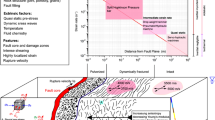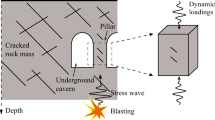Abstract
The mechanical behavior of rocks under cyclic loading has been widely studied, while the effect of microstructure on the dynamic responses of rocks was not well clarified. A series of uniaxial monotonic and coupled static–dynamic tests were performed on two microstructurally different rocks, i.e. red sandstone and granite, with the combination of digital image correlation (DIC) and acoustic emission (AE) techniques. Experimental results revealed that dynamic disturbances have a large role in the damage evolution and fracturing mechanism of rocks. A two- or three-stage evolution trend is observed in the variations of axial strain and cumulative AE counts during cyclic disturbances. The microstructure within rocks significantly affects the dynamic responses of rocks. The cyclic disturbance or disturbance history greatly enhances the strength and brittleness of red sandstone specimens and induces more energetic fractures. The failure mechanism of red sandstone is correlated to both intercrystalline slip and microfracturing. The inclined strain bands resulting from the irreversible deformation first merge, and then several short cracks appear in the form of high-strain bands and further coalesce as the cyclic disturbances proceed. Different from the red sandstone specimen, the granite specimen starts to generate abundant microcracks at high static stress, and those cracks are further activated, blunted, and unstably propagated during cyclic disturbances, resulting in tensile failure at a stress level much lower than its UCS. In addition, cyclic disturbances can induce more major tensile cracks and promote crack branching in granite specimens. The dynamic instability of the two microstructurally different rocks is generally preceded by an abrupt increase in the AE count rate and a decrease in the b value, which can be utilized for disaster prediction in rock and mining engineering.
Highlights
-
The coupled static-dynamic tests were performed on microstructurally different rocks.
-
The effect of rock microstructure on the dynamic responses of rocks is clarified.
-
The dynamic failure of rocks is preceded by an abrupt increase in AE rate and a decrease in b value.


























Similar content being viewed by others
References
Aggelis DG, Mpalaskas AC, Matikas TE (2013) Acoustic signature of different fracture modes in marble and cementitious materials under flexural load. Mech Res Commun 47:39–43. https://doi.org/10.1016/j.mechrescom.2012.11.007
Akesson U, Hansson J, Stigh J (2004) Characterisation of microcracks in the Bohus granite, western Sweden, caused by uniaxial cyclic loading. Eng Geol 72:131–142. https://doi.org/10.1016/j.enggeo.2003.07.001
Arora K, Chakraborty T, Rao KS (2019) Experimental study on stiffness degradation of rock under uniaxial cyclic sinusoidal compression loading. Rock Mech Rock Eng 52:4785–4797. https://doi.org/10.1007/s00603-019-01835-3
Bagde MN, Petroš V (2009) Fatigue and dynamic energy behaviour of rock subjected to cyclical loading. Int J Rock Mech Min Sci 46:200–209. https://doi.org/10.1016/j.ijrmms.2008.05.002
Burdine NT (1963) Rock failure under dynamic loading conditions. Soc Petrol Eng J 3:1–8
Cerfontaine B, Collin F (2017) Cyclic and fatigue behaviour of rock materials: review, interpretation and research perspectives. Rock Mech Rock Eng 51:391–414. https://doi.org/10.1007/s00603-017-1337-5
Chen Y, Watanabe K, Kusuda H, Kusaka E, Mabuchi M (2011) Crack growth in westerly granite during a cyclic loading test. Eng Geol 117:189–197. https://doi.org/10.1016/j.enggeo.2010.10.017
Chen Y, Zuo J, Guo B, Guo W (2019) Effect of cyclic loading on mechanical and ultrasonic properties of granite from Maluanshan Tunnel. Bull Eng Geol Env 79:299–311. https://doi.org/10.1007/s10064-019-01563-6
Duan M, Jiang C, Gan Q, Li M, Peng K, Zhang W (2020) Experimental investigation on the permeability, acoustic emission and energy dissipation of coal under tiered cyclic unloading. J Nat Gas Sci Eng. https://doi.org/10.1016/j.jngse.2019.103054
Eberhardt E, Stead D, Stimpson B, Read RS (1998) Identifying crack initiation and propagation thresholds in brittle rock. Can Geotech J 35:222–233
Erarslan N, Williams DJ (2012) Mechanism of rock fatigue damage in terms of fracturing modes. Int J Fatigue 43:76–89. https://doi.org/10.1016/j.ijfatigue.2012.02.008
Fan J, Chen J, Jiang D, Ren S, Wu J (2016) Fatigue properties of rock salt subjected to interval cyclic pressure. Int J Fatigue 90:109–115. https://doi.org/10.1016/j.ijfatigue.2016.04.021
Feng X-T, Gao Y, Zhang X, Wang Z, Zhang Y, Han Q (2020) Evolution of the mechanical and strength parameters of hard rocks in the true triaxial cyclic loading and unloading tests. Int J Rock Mech Min Sci. https://doi.org/10.1016/j.ijrmms.2020.104349
Feng XT (2017) Rockburst: mechanisms, monitoring, warning, and mitigation. Butterworth-Heinemann, Oxford
Fuenkajorn K, Phueakphum D (2010) Effects of cyclic loading on mechanical properties of Maha Sarakham salt. Eng Geol 112:43–52. https://doi.org/10.1016/j.enggeo.2010.01.002
Geranmayeh Vaneghi R, Ferdosi B, Okoth AD, Kuek B (2018) Strength degradation of sandstone and granodiorite under uniaxial cyclic loading. J Rock Mech Geotech Eng 10:117–126. https://doi.org/10.1016/j.jrmge.2017.09.005
Geranmayeh Vaneghi R, Thoeni K, Dyskin AV, Sharifzadeh M, Sarmadivaleh M (2020) Strength and damage response of sandstone and granodiorite under different loading conditions of multistage uniaxial cyclic compression. Int J Geomech. https://doi.org/10.1061/(asce)gm.1943-5622.0001801
Ghamgosar M, Erarslan N (2015) Experimental and numerical studies on development of fracture process zone (FPZ) in rocks under cyclic and static loadings. Rock Mech Rock Eng 49:893–908. https://doi.org/10.1007/s00603-015-0793-z
Goebel THW, Schorlemmer D, Becker TW, Dresen G, Sammis CG (2013) Acoustic emissions document stress changes over many seismic cycles in stick-slip experiments. Geophys Res Lett 40:2049–2054. https://doi.org/10.1002/grl.50507
Gong F, Zhang L, Li X, Luo Y (2017) Experimental study on fracture behaviors of hard rock under dynamic disturbance with different pre-static loads. Yanshilixue Yu Gongcheng Xuebao/chin J Rock Mech Eng 36:1841–1854
Gutenberg B, Richter CF (1994) Frequency of earthquakes in California. Bull Seismol Soc Am 34:185–188
He MC, Miao JL, Feng JL (2010) Rock burst process of limestone and its acoustic emission characteristics under true-triaxial unloading conditions. Int J Rock Mech Min Sci 47:286–298. https://doi.org/10.1016/j.ijrmms.2009.09.003
Konicek P, Saharan MR, Mitri H (2011) Destress blasting in coal mining—state-of-the-art review. Procedia Eng 26:179–194. https://doi.org/10.1016/j.proeng.2011.11.2157
Li X et al (2017) Failure mechanism and coupled static-dynamic loading theory in deep hard rock mining: a review. J Rock Mech Geotech Eng 9:767–782. https://doi.org/10.1016/j.jrmge.2017.04.004
Ma L-j et al (2013) Experimental investigation of the mechanical properties of rock salt under triaxial cyclic loading. Int J Rock Mech Min Sci 62:34–41. https://doi.org/10.1016/j.ijrmms.2013.04.003
Martin CD (1993) The strength of massive Lac du Boinnet granite around underground openings. PhD Thesis, Department of Civil and Geological Engineering, University of Manitoba, Winnipeg, Manitoba
Martin C, Chandler N (1994) The progressive fracture of Lac du Bonnet granite. Int J Rock Mech Min Sci Geomech Abstr 31:643–659
Miao S, Pan P-Z, Konicek P, Yu P, Liu K (2021) Rock damage and fracturing induced by high static stress and slightly dynamic disturbance with acoustic emission and digital image correlation techniques. J Rock Mech Geotech Eng 13:1002–1019
Miao S, Pan P-Z, Zhao X, Shao C, Yu P (2020) Experimental study on damage and fracture characteristics of Beishan granite subjected to high-temperature treatment with DIC and AE techniques. Rock Mech Rock Eng. https://doi.org/10.1007/s00603-020-02271-4
Momeni A, Karakus M, Khanlari GR, Heidari M (2015) Effects of cyclic loading on the mechanical properties of a granite. Int J Rock Mech Min Sci 77:89–96. https://doi.org/10.1016/j.ijrmms.2015.03.029
Munoz H, Taheri A (2017) Local damage and progressive localisation in porous sandstone during cyclic loading. Rock Mech Rock Eng 50:3253–3259. https://doi.org/10.1007/s00603-017-1298-8
Nejati HR, Ghazvinian A (2013) Brittleness effect on rock fatigue damage evolution. Rock Mech Rock Eng 47:1839–1848. https://doi.org/10.1007/s00603-013-0486-4
Nicksiar M, Martin CD (2012) Evaluation of methods for determining crack initiation in compression tests on low-porosity rocks. Rock Mech Rock Eng 45:607–617. https://doi.org/10.1007/s00603-012-0221-6
Peng K, Wang Y, Zou Q, Liu Z, Mou J (2019) Effect of crack angles on energy characteristics of sandstones under a complex stress path. Eng Fract Mech. https://doi.org/10.1016/j.engfracmech.2019.106577
Singh SK (1989) Fatigue and strain hardening behaviour of graywacke from the flagstaff formation, New South Wales. Eng Geol 26:171–179
Su G et al (2017) True triaxial experimental study of rockbursts induced by ramp and cyclic dynamic disturbances. Rock Mech Rock Eng 51:1027–1045. https://doi.org/10.1007/s00603-017-1384-y
Taheri A, Royle A, Yang Z, Zhao Y (2015) Study on variations of peak strength of a sandstone during cyclic loading. Geomech Geophys Geo-Energy Geo-Resour 2:1–10. https://doi.org/10.1007/s40948-015-0017-8
Taheri A, Yfantidis N, Olivares CL, Connelly BJ, Bastian TJ (2016) Experimental study on degradation of mechanical properties of sandstone under different cyclic loadings. Geotech Test J. https://doi.org/10.1520/gtj20150231
Tang L, Wu J, Liu T, Zhu J, Shu J (2014). Mechanical experiments of marble under high stress and cyclic dynamic disturbance of small amplitude. J Central South Univ (Sci Technol) 45:4300–4307
Trippetta F, Collettini C, Meredith PG, Vinciguerra S (2013) Evolution of the elastic moduli of seismogenic Triassic Evaporites subjected to cyclic stressing. Tectonophysics 592:67–79. https://doi.org/10.1016/j.tecto.2013.02.011
Wang J-H, Chen K-C, Leu P-L, Chang C-H (2016) Precursor times of abnormal b-values prior to main shocks. J Seismol 20:905–919. https://doi.org/10.1007/s10950-016-9567-7
Wang Y, Gao SH, Han JQ (2020) Fatigue-damage evolution characteristics of interbedded marble subjected to dynamic uniaxial cyclic loads. Geotech Geol Eng. https://doi.org/10.1007/s10706-020-01526-9
Xiao J-Q, Ding D-X, Jiang F-L, Xu G (2010) Fatigue damage variable and evolution of rock subjected to cyclic loading. Int J Rock Mech Min Sci 47:461–468. https://doi.org/10.1016/j.ijrmms.2009.11.003
Xiao J-Q, Ding D-X, Xu G, Jiang F-L (2009) Inverted S-shaped model for nonlinear fatigue damage of rock. Int J Rock Mech Min Sci 46:643–648. https://doi.org/10.1016/j.ijrmms.2008.11.002
Xiao J, Ding D, Xu G, Jiang F (2008) Waveform effect on quasi-dynamic loading condition and the mechanical properties of brittle materials. Int J Rock Mech Min Sci 45:621–626
Yang F, Hu D, Zhou H, Lu J (2020a) Physico-mechanical behaviors of granite under coupled static and dynamic cyclic loadings. Rock Mech Rock Eng 53:2157–2173. https://doi.org/10.1007/s00603-019-02040-y
Yang S-Q, Huang Y-H, Tang J-Z (2020b) Mechanical, acoustic, and fracture behaviors of yellow sandstone specimens under triaxial monotonic and cyclic loading. Int J Rock Mech Min Sci. https://doi.org/10.1016/j.ijrmms.2020.104268
Yang S-Q, Tian W-L, Ranjith PG (2017) Experimental investigation on deformation failure characteristics of crystalline marble under triaxial cyclic loading. Rock Mech Rock Eng 50:2871–2889. https://doi.org/10.1007/s00603-017-1262-7
Zhao K, Ma H, Yang C, Chen X, Liu Y, Liang X, Cai R (2021) Damage evolution and deformation of rock salt under creep-fatigue loading. Rock Mech Rock Eng. https://doi.org/10.1007/s00603-020-02342-6
Zheng Q, Liu E, Sun P, Liu M, Yu D (2020a) Dynamic and damage properties of artificial jointed rock samples subjected to cyclic triaxial loading at various frequencies. Int J Rock Mech Min Sci. https://doi.org/10.1016/j.ijrmms.2020.104243
Zheng Q, Liu E, Yu D, Liu M (2020b) Fatigue and damage properties of non-consecutive jointed mudstone samples subjected to cyclic triaxial loading. Bull Eng Geol Env 79:2467–2481. https://doi.org/10.1007/s10064-019-01693-x
Zhu WC, Tang CA (2006) Numerical simulation of Brazilian disk rock failure under static and dynamic loading. Int J Rock Mech Min Sci 43:236–252. https://doi.org/10.1016/j.ijrmms.2005.06.008
Zhu X-Y, Chen X-D, Dai F (2020) Mechanical properties and acoustic emission characteristics of the bedrock of a hydropower station under cyclic triaxial loading. Rock Mech Rock Eng. https://doi.org/10.1007/s00603-020-02218-9
Acknowledgements
This work was supported by National Natural Science Foundation of China (Grant Nos. 52125903 and 51621006).
Author information
Authors and Affiliations
Corresponding author
Additional information
Publisher's Note
Springer Nature remains neutral with regard to jurisdictional claims in published maps and institutional affiliations.
Rights and permissions
About this article
Cite this article
Miao, S., Pan, PZ., Yu, P. et al. Fracture Behaviour of Two Microstructurally Different Rocks Exposed to High Static Stress and Cyclic Disturbances. Rock Mech Rock Eng 55, 3621–3644 (2022). https://doi.org/10.1007/s00603-022-02810-1
Received:
Accepted:
Published:
Issue Date:
DOI: https://doi.org/10.1007/s00603-022-02810-1




